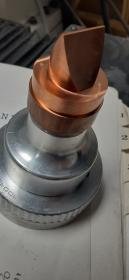Hi bigfloyd:
You're 99% of the way there...I can tell because you have an electrode that clearly has made it pretty much all the way down the cavity.
So you managed a successful burn.
What, specifically are you still having trouble with?
Is the burn stalling part way down?
Are you taking more time than you (or your boss) think is reasonable?
Are you unable to hit dimensions or geometric fidelity?
Are you unable to get the finish you desire?
Is the leftover flushing tit from the roughing interfering with the finishing?
Is the electrode wearing excessively?
Are you unhappy with the burn settings for copper electrodes on your machine?
Did you know the settings for copper are typically quite different from the settings for graphite, and that copper has limitations that graphite does not have?
From what I can see, there are only two comments I have.
Your electrode could stand to be longer and the flange gets in the way.
Ideally you want a nice escape path for the burn debris and you want a place you can point a flushing wand onto, to help wash the body of the electrode every time it is retracted from the burn.
You could also probably benefit from having more and smaller flushing lines drilled through and directed to the pointy end of the trode, especially out toward the corners of the cavity where it's harder to flush and more prone to arcing.
Once you break through the part thickness, all those flushing lines become kind of pointless unless you seal the workpiece so the dielectric oil is still forced through the spark gap instead of just pissing out the slot at the bottom of the burn.
Setting the part on a plate is all you need...the seal does not have to be perfect...just good enough that the dielectric oil is forced mostly through the spark gap.
Regarding your question about flushing lines...there are two kinds; the internal lines like you've drilled into the electrode, and external ones that are simply hoses you point at the electrode or at the cavity and piss dielectric oil out of to wash the cavity walls or the electrode walls or both.
The internal lines can be pressure flushing lines where the dielectric comes out of the trode, and washes through the spark gap, or vacuum lines where the dielectric and the cut debris is sucked through the electrode, and the oil is supplied from the tank.
Sometimes vacuum flushing will be beneficial...I doubt this is one of those cases, but there's no harm in trying.
Every modern sinker has vacuum flushing ability, you just have to find out how to hook it up on your particular machine.
On mine you have to swap a hose from the trode to the dielectric manifold...yours may be different.
Cheers
Marcus
Implant Mechanix • Design & Innovation > HOME
Vancouver Wire EDM -- Wire EDM Machining







